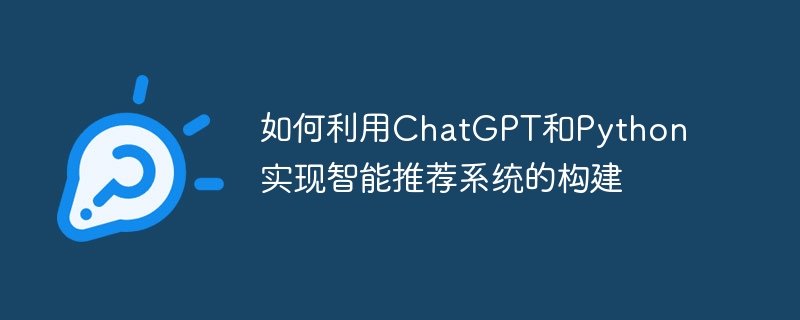Home >Backend Development >Python Tutorial >How to use ChatGPT and Python to build an intelligent recommendation system
How to use ChatGPT and Python to build an intelligent recommendation system
- PHPzOriginal
- 2023-10-27 16:37:471274browse

How to use ChatGPT and Python to build an intelligent recommendation system
The recommendation system is a technology widely used in current Internet applications. It can be based on the user's interests and Behavioral data is used to recommend personalized content and products to users. ChatGPT is an artificial intelligence-based machine learning model focused on conversation generation. Combining ChatGPT and Python, we can implement an intelligent recommendation system to provide users with more accurate and personalized recommendations.
Step 1: Data collection and preprocessing
First, we need to collect and prepare the data required by the recommendation system. These data can be users' historical behavior data, product information data, etc. Depending on actual needs, we may need to clean, format, and convert the data to facilitate subsequent processing and model training.
Step 2: Build the ChatGPT model
Next, we need to use Python to build the ChatGPT model. You can use open source libraries such as OpenAI's GPT-3 SDK to quickly implement this step. By calling ChatGPT's API, we can use the user's input as a question, and then use ChatGPT's generated results as recommended answers.
The following is a simple example code that uses Python to call ChatGPT to answer questions:
import openai
openai.api_key = 'your_api_key'
def chat_with_gpt(question):
response = openai.Completion.create(
engine='text-davinci-002',
prompt=question,
max_tokens=100,
temperature=0.6,
n=1,
stop=None,
log_level='info',
)
answer = response.choices[0].text.strip()
return answer
# 调用ChatGPT回答问题
question = '你能推荐一些适合我看的电影吗?'
answer = chat_with_gpt(question)
print(answer)Step 3: Recommended logical design
After getting the answer from ChatGPT, we need to base on the content of the answer Design recommendation logic. Depending on the specific recommendation needs, the following factors can be considered:
- User's historical behavior: Recommend similar content or products based on the user's historical browsing and purchase records.
- User's interest tags: Recommend content or products related to the user's interests based on the user's interest tags.
- Popular recommendations: Recommend popular content or products to users based on the current popular content or products.
- Partner recommendation: Provide users with relevant content or products based on the recommendation information provided by partners.
Based on actual needs, we can combine the above factors to design our recommendation logic.
Step 4: Integrate ChatGPT and recommendation logic
Finally, we integrate ChatGPT’s answers and recommendation logic to form a complete intelligent recommendation system. According to the user's input question, ChatGPT is first called to generate an answer, and then based on the generated answer and combined with the recommendation logic, the corresponding content or product is recommended to the user.
The following is a sample code that uses Python to integrate ChatGPT and recommendation logic:
def recommend_content(question):
answer = chat_with_gpt(question)
# 根据生成的回答,结合推荐逻辑,给用户推荐相关的内容或产品
# TODO: 实现推荐逻辑
return recommendation
# 调用ChatGPT和推荐逻辑来推荐内容
question = '你能推荐一些适合我看的电影吗?'
recommendation = recommend_content(question)
print(recommendation)The above sample code is just a simple reference, and needs to be adjusted and optimized according to specific needs in actual applications.
Summary
By combining ChatGPT and Python, we can implement an intelligent recommendation system to provide users with personalized recommendations. Key steps include data collection and preprocessing, building a ChatGPT model, recommending logic design, and integrating ChatGPT and recommendation logic. Through continuous optimization and iteration, we can build a more accurate and intelligent recommendation system to improve user experience and satisfaction.
The above is the detailed content of How to use ChatGPT and Python to build an intelligent recommendation system. For more information, please follow other related articles on the PHP Chinese website!
Related articles
See more- How to program a heart in Python
- How to output newline in python
- 3-minute quick tutorial on how to use ChatGPT. Use it to help me write my resume. It's awesome.
- I used ChatGPT + Midjourney to draw all the protagonists of 'Game of Thrones'
- Golang builds an intelligent recommendation system: using Baidu AI interface to implement product recommendations

